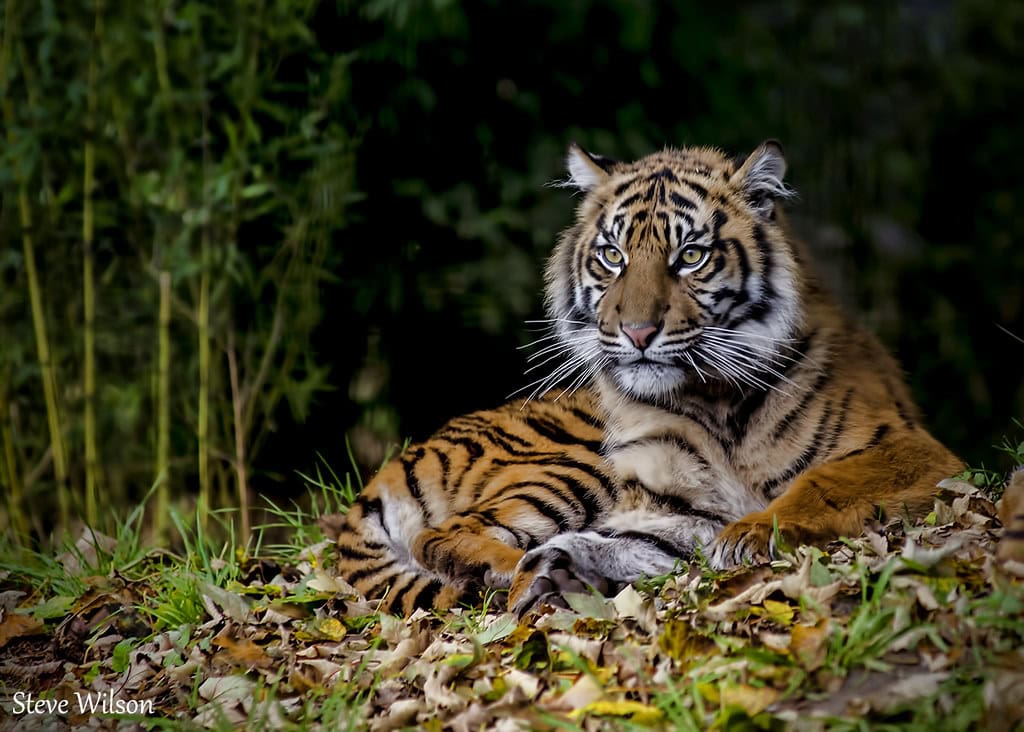Tigers have captured human imagination for centuries with their raw power and stunning beauty. These magnificent big cats prowl through dense jungles and grasslands across Asia, commanding respect as nature’s perfect predators. But beyond their fearsome reputation and striking appearance, tigers harbor secrets that might surprise even the most devoted wildlife enthusiasts. From their remarkable swimming abilities to hidden features that act like built-in night vision goggles, these solitary hunters are far more complex than you might imagine. Let’s dive into the extraordinary world of tigers and uncover nine fascinating facts that reveal just how incredible these endangered giants really are.
Tigers Have False Eyes on Their Ears for Protection

If you’ve ever gotten a close look at a tiger’s ears, you might have noticed something unusual – tigers have prominent white markings on their ears. From certain angles, it may not look like anything special, but when seen from a particular direction they actually look like large eyes. Known as eyespots, this type of self-mimicry is actually fairly common—and isn’t limited to cats. These remarkable markings serve a dual purpose in the tiger’s survival toolkit. One theory is that the eyespots help protect tigers when they are drinking. As one of the few situations where the powerful cat is vulnerable, it’s also when the markings are fully on display. When taking a drink, tigers typically have their ears pinned back and, as they’re bending over, it appears that they have even larger eyes. This would scare any other animal who might think to take advantage of the situation—as they’d be tricked into thinking the tiger was on alert. Additionally, there are those who believe that a tiger uses their eyespots as a form of aggressive communication. When tigers are threatened, they twist their ears to the front and display the white markings prominently.
Every Tiger’s Stripe Pattern is as Unique as Human Fingerprints

Not unlike human fingerprints, the pattern of every tiger’s stripes is one of a kind. When you look at different tigers up close, as I do in my work, you’ll see that each of their stripe patterns is unique, just like a zebra’s. No two are the same. They’re as distinct as human fingerprints. This uniqueness isn’t just limited to their fur patterns. It isn’t just a tiger’s fur that’s striped. Their skin is similarly marked, and the pattern mirrors that of their fur. Scientists have compared this to a beard’s five-o’clock shadow, as a tiger’s colored hair follicles are embedded in their skin and therefore visible to the naked eye. This allows researchers who study them in the wild to identify and count individual tigers. They use remote cameras to take pictures of the animals when they walk by. Using this method, tiger experts estimate that only about 3,400 wild tigers remain across their Asian homeland. The genetic basis for these patterns is incredibly complex, with genetics playing a major role in the formation of tiger stripes. The genes responsible for the pigmentation of a tiger’s fur are passed down from its parents, and variations in these genes can result in different patterns of stripes. This is why no two tigers have the same pattern of stripes.
Their Night Vision is Six Times Better Than Humans

Tigers are nature’s ultimate night hunters, and their extraordinary vision is the secret weapon behind their success. Tigers have night vision that is six times better than that of humans, which helps them hunt successfully in the dark. Tiger eyes are built with large lenses and pupils that welcome more light than our own eyes do. This design is a big help for seeing in the low light of the nocturnal hours. Just imagine being able to see six times better than humans when the lights go out—that’s the kind of super vision tigers have thanks to all those handy rod cells in their retinas. The real magic happens behind their retinas, where a unique feature, the tapetum lucidum, lies behind the tiger’s retina. This mirror-like layer reflects light that passes through the retina, enhancing sight in darkness. It’s why tigers’ eyes often seem to glow when caught in light. Their night vision, thought to be about six times better than that of humans, stems from this adaptation that turns dim into bright, making the night almost as clear as day for these majestic cats. Tigers have more rods (responsible for visual acuity for shapes) in their eyes than cones (responsible for color vision) to assist with their night vision. The increased number of rods allows them to detect movement of prey in darkness where color vision would not be useful.
Tigers are Excellent Swimmers Who Love Water

Unlike most cats who despise getting wet, tigers have an almost aquatic lifestyle that would make any house cat cringe. Tigers, unlike many other cat species, readily enter water to cool themselves and in the pursuit of prey. They are powerful swimmers and capable of traversing lakes and rivers. The tiger is a powerful swimmer and easily transverses rivers as wide as 8 km (5.0 mi); it immerses in water, particularly on hot days. This aquatic ability isn’t just for cooling off during hot weather – tigers actually hunt in water too. Tigers are adept swimmers and have even been recorded hunting in the water. In fact, unlike the domestic cats, its larger version enjoy spending time in the water and they love to swim for hours. Since cubs, female Tigers encourage or help learn the art of hunting, they even have the ability to kill in the water. And as adults, it is said that they can swim for several kilometres and even have reported one to swim for 30 km in just a day. This swimming prowess makes tigers incredibly versatile predators, able to pursue prey both on land and in aquatic environments where other big cats would struggle.
They’re Actually Invisible to Their Prey

Here’s where things get really interesting – that bright orange coat that makes tigers so visible to us actually works as perfect camouflage in the wild. Tigers appear orange to humans because most of us are trichromatic (or sensitive to all three primary colors). But boars, deer, and other tiger prey are dichromatic and only pick up green and blue light. They’re effectively colorblind to red, like some people. Their prey don’t see colors the way we do. Deer, for instance, can process short and mid-wavelength colors such as green and blue but not long wavelength hues such as red and orange. That means a tiger lurking in the grass won’t look bright orange — it will actually appear green to its prey, making it difficult to differentiate from its surroundings. To their eyes, the tiger’s fur isn’t bright orange: it looks green and matches the background. The vertical stripes add another layer of deception, creating what biologists call disruptive coloration, as their vertical slashes help them hide in plain sight by breaking up their shape and size so they blend in with tall grass, trees, and other camouflage-friendly environments. This evolutionary adaptation gives tigers a tremendous advantage as tigers are solitary hunters who ambush their prey, so the ability to remain undetected while on the hunt is key to their survival.
Tigers are Completely Solitary Except During Mating

While lions live in prides and hunt together, tigers are the ultimate loners of the big cat world. Tigers are territorial and usually solitary in nature. Tigers are usually solitary in nature, interacting briefly only for mating purposes and occasionally to share their kill. Tigers are considered as solitary animals. Unlike the sights of multiple tigers kept in one cage in the zoos, you are less likely to spot the same age group of tigers roaming together in the wild. Tigers like to stay alone, they are often observed taking a leisure walk all by themselves or perhaps building his strategies for his next meal. This solitary lifestyle extends to their hunting strategies, where tigers are semi-solitary and depend on their cryptic appearance to ambush prey. Adult tigers lead largely solitary lives within home ranges or territories, the size of which mainly depends on prey abundance, geographic area and sex of the individual. Territory sizes can vary dramatically based on prey availability – for male tigers in Ranthambhore India; the prey concentrations are high and male tigers have territories that range in size from 5 to 150 km2 (2 to 60 mi2). In Siberia the prey concentrations are much lower and male tiger territories range in size from 800 to 1200 km2 (320 to 480 mi2). However, there has been a few rare instances documented in which tigers have collaborated on a hunt, similar to a pride of lions.
They Can Eat 80 Pounds of Meat in One Sitting

When it comes to appetite, tigers take the concept of “feast or famine” to extreme levels. A tiger can consume more than 80 pounds of meat at one time. To put this in perspective, that’s equivalent to eating about 320 quarter-pound hamburgers in a single meal! This incredible consumption capacity makes sense when you consider their hunting success rate. For tigers only one in ten hunts are successful; a large deer can provide a tiger with one week’s food. A large deer can provide a tiger with one week’s food, but only one out of every ten hunts is successful. Tigers have developed sophisticated food storage behaviors to maximize their hunting efforts. Tigers don’t usually eat their prey at the kill site – but instead drag their prey into cover to feed. If a tiger leaves – say to get a drink – it will cover it’s kill by raking leaves, dirt, grass and even rocks over the carcass. The Tigers have a varied diet and can feast on anything that comes its way, be it, a wild boar, deer/antelope, rodent, bear, bird, rhino, crocodile, buffalo and even their own group of cats like leopards. They even eat fish! Their powerful jaws and somewhat curved canines are the longest in the cat family at 6.4–7.6 cm (2.5–3.0 in) make quick work of even the largest prey.
Tigers Can Mimic the Calls of Other Animals to Hunt

Perhaps one of the most cunning facts about tigers is their ability to deceive prey through vocal mimicry. Tigers imitate the call of other animals! I had that same expression and it aroused me to dig deeper and found a positive answer, they certainly can. Hunting by mimicry is an added advantage to animals; it has been said that Tigers make a ‘pook’ sound similar to that of sambhar that draws these innocent animals into the trap and get ambushed. This sophisticated hunting technique showcases the intelligence and adaptability that makes tigers such effective predators. Beyond mimicry, tigers have an extensive vocal repertoire for communication. The vocal repertoire of tigers is vast – they grunt, growl, roar, moan, snarl, chuff, hiss and gasp. It’s thought that each vocalisation is used to communicate different things. A tiger’s roar can be heard from 3 kilometres away, making it one of the most powerful vocalizations in the animal kingdom. Despite their solitary nature, communication is a very important part of tigers’ behavioral ecology. They communicate through vocalizations, such as roaring, grunting and chuffing, and through signals, such as scent marking and scratches on trees. Tigers are fiercely territorial animals, so these signals are particularly important to communicating where one tiger’s home range ends and another’s begins.
There are More Tigers in US Captivity Than in the Wild

This final fact might be the most shocking of all. There are more tigers in captivity in the US than are left in the wild. There are 3,900 tigers in the wild and both China and the US each have over an estimated 5,000 tigers in captivity. There are more tigers in captivity in the US than there are in the wild in Asia. In just the US, there are as many as 10,000 big cats in captivity, and they often are subject to terrible living conditions. The wild tiger population tells a heartbreaking story of decline. Over the last 150 years, the tigers’ range has shrunk by nearly 95%. While tigers have been around longer than humans, the impacts of human development have caused their population to decline by 97% since the start of the last century. However, there’s a glimmer of hope on the horizon. After a century of decline, overall wild tiger numbers are starting to tick upward. Based on the best available information, tiger populations are stable or increasing in India, Nepal, Bhutan, Russia and China. About 5,574 tigers remain in the wild, according to the Global Tiger Forum, but much more work is needed to protect this species if we are to secure its future in the wild. Conservation efforts continue to work toward the ambitious goal of doubling wild tiger populations, though in some areas, including much of Southeast Asia, tigers are still in crisis and declining in number.
Conclusion

Tigers continue to amaze us with their incredible adaptations and complex behaviors that have evolved over millions of years. From their deceptive camouflage that makes them invisible to prey, to their remarkable swimming abilities and sophisticated hunting techniques, these magnificent cats represent one of nature’s most perfect predators. Yet despite their incredible abilities, tigers face an uncertain future as their wild populations remain critically low. Understanding these fascinating facts about tigers not only deepens our appreciation for these majestic creatures but also reminds us why their conservation is so crucial. Every tiger saved represents not just a single life, but the continuation of millions of years of evolutionary perfection. What surprised you most about these incredible cats?
- 10 Animals That Risked Their Lives to Save Humans - August 9, 2025
- 14 Reasons Why Bears Are Afraid of Humans (Most of the Time) - August 9, 2025
- 11 Frogs That Look Too Weird to Be Real - August 9, 2025

